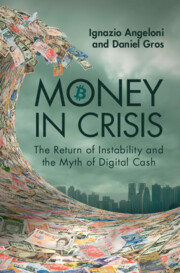Refine search
Actions for selected content:
50 results
7 - Worth Its Weight
- from Part III - Trust
-
-
- Book:
- How Transparency Works
- Published online:
- 02 January 2026
- Print publication:
- 29 January 2026, pp 145-168
-
- Chapter
-
- You have access
- Open access
- HTML
- Export citation
Chapter 4 - Risk and Uncertainty in Finance
-
- Book:
- Entanglements in World Politics
- Published online:
- 27 November 2025
- Print publication:
- 11 December 2025, pp 133-174
-
- Chapter
-
- You have access
- Open access
- HTML
- Export citation
7 - Politicizing Financial Innovations for Transformative Climate Justice
- from Part II - Political Economy
-
-
- Book:
- Stability and Politicization in Climate Governance
- Published online:
- 07 August 2025
- Print publication:
- 21 August 2025, pp 99-112
-
- Chapter
-
- You have access
- Open access
- HTML
- Export citation

Money In Crisis
- The Return of Instability and the Myth of Digital Cash
-
- Published online:
- 15 July 2025
- Print publication:
- 12 June 2025
2 - Money and Technology in Ancient Times
-
- Book:
- Money In Crisis
- Published online:
- 15 July 2025
- Print publication:
- 12 June 2025, pp 14-45
-
- Chapter
- Export citation
14 - Money in Crisis and the Possible Future
-
- Book:
- Money In Crisis
- Published online:
- 15 July 2025
- Print publication:
- 12 June 2025, pp 353-361
-
- Chapter
- Export citation
10 - Central Bank Digital Currencies
-
- Book:
- Money In Crisis
- Published online:
- 15 July 2025
- Print publication:
- 12 June 2025, pp 257-288
-
- Chapter
- Export citation
Chapter 4 - Infrastructural Power in Financial Governance
- from Part I - Conceptual Approaches
-
-
- Book:
- The Cambridge Global Handbook of Financial Infrastructure
- Published online:
- 21 May 2025
- Print publication:
- 05 June 2025, pp 37-48
-
- Chapter
-
- You have access
- Open access
- HTML
- Export citation
Redefining scientization: Central banks between science and politics
-
- Journal:
- Finance and Society / Volume 11 / Issue 2 / August 2025
- Published online by Cambridge University Press:
- 22 April 2025, pp. 209-229
-
- Article
-
- You have access
- Open access
- HTML
- Export citation
Enacting efficient markets: The performativity of quantitative easing
-
- Journal:
- Finance and Society / Volume 11 / Issue 1 / April 2025
- Published online by Cambridge University Press:
- 30 January 2025, pp. 1-20
-
- Article
-
- You have access
- Open access
- HTML
- Export citation
1 - Introduction
-
- Book:
- There Will Be the Devil to Pay
- Published online:
- 21 December 2024
- Print publication:
- 09 January 2025, pp 1-21
-
- Chapter
- Export citation
1 - The Moneychanger State
-
- Book:
- Money, Value, and the State
- Published online:
- 05 December 2024
- Print publication:
- 12 December 2024, pp 51-91
-
- Chapter
- Export citation
Central Banks as Regulators and (also) Operators of Instant Payments Schemes: Confronting the Criticisms of “Needless Intervention” and “Unfair Competition”
-
- Journal:
- European Journal of Risk Regulation / Volume 16 / Issue 1 / March 2025
- Published online by Cambridge University Press:
- 10 October 2024, pp. 263-278
-
- Article
-
- You have access
- Open access
- HTML
- Export citation
Central bank digital currencies: an old tale with a new chapter
-
- Journal:
- Financial History Review / Volume 31 / Issue 1 / April 2024
- Published online by Cambridge University Press:
- 18 September 2024, pp. 94-122
-
- Article
- Export citation
AUTOMATED DETECTION OF EMOTION IN CENTRAL BANK COMMUNICATION: A WARNING
-
- Journal:
- National Institute Economic Review / Volume 269 / Autumn 2024
- Published online by Cambridge University Press:
- 21 February 2025, pp. 82-91
- Print publication:
- Autumn 2024
-
- Article
-
- You have access
- Open access
- HTML
- Export citation
INTRODUCTION TO THE SPECIAL ISSUE ON ‘CURRENT ISSUES IN CENTRAL BANKING’
-
- Journal:
- National Institute Economic Review / Volume 269 / Autumn 2024
- Published online by Cambridge University Press:
- 20 May 2025, pp. 1-3
- Print publication:
- Autumn 2024
-
- Article
- Export citation
1 - History of Central Banking
- from Part I - The Theoretical Foundations
-
- Book:
- Reconsidering Central Bank Independence
- Published online:
- 25 April 2024
- Print publication:
- 02 May 2024, pp 3-18
-
- Chapter
- Export citation
Same Naira, More Possibilities! Assessing the Legal Status of the eNaira and Its Potential for Privacy and Inclusion
-
- Journal:
- Journal of African Law / Volume 68 / Issue 2 / June 2024
- Published online by Cambridge University Press:
- 13 March 2024, pp. 245-262
- Print publication:
- June 2024
-
- Article
-
- You have access
- Open access
- HTML
- Export citation
Applause, puzzlement, worry
-
- Journal:
- Finance and Society / Volume 10 / Issue 1 / April 2024
- Published online by Cambridge University Press:
- 06 March 2024, pp. 75-81
-
- Article
-
- You have access
- Open access
- HTML
- Export citation
1 - Introduction
-
- Book:
- Taming the Cycles of Finance?
- Published online:
- 15 February 2024
- Print publication:
- 22 February 2024, pp 1-22
-
- Chapter
- Export citation
